
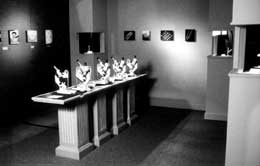 Can
you tell us when "The Museum of Jurassic Technology" started, when
it was founded?
Can
you tell us when "The Museum of Jurassic Technology" started, when
it was founded?
Wilson: The museum has been here for about 9 years, but it actually began many years before that, it`s almost 15 years old, now. But, for the first 7 or 8 years the exhibits of the museum travelled from one place to another. We didn`t have a home, so we went to different kinds of cultural institutions, mostly around the western states. But we always knew that the thing we wanted to do was to have a place of our own. It just took us until 1988 before we were able to do it. When we began, we were given a donation by a woman named Mary Rose (Kahn?). She had received from her grandfather a large collection of very curious objects. When she heard that we were starting this project, she donated them to us and that became our foundation collection. Most of the things from that collection are now in the branch in Hagen. When we began that branch, we began with exhibitions from our foundation collections. So we then opened here about 1988.
The first exhibitions, the travelling exhibitions, were they set up in the same style?
Wilson: They were very much the same. I mean, some of the things here were part of the exhibitions that travelled. A few of the things that remain here now, were in those travelling exhibitions. There were others, that we just have lost or don't have room for anymore. Some of them are in storage and we would like to show them, but there isn't the room.
We saw this "board of members".Do they support the museum?
Wilson: It`s actually much larger than that now. We have about probably 300 members. We don`t have any members, that give enormous amounts of money Our members give from between 25 up to a couple of thousand Dollars.
What was the motivation to start it?
Wilson: I think, for almost everybody involved in the museum now, one of the major motivations is, that we all very much love museums. And as kids, we all probably spent too much time in museums. And all of us wanted in some way or another to be involved in that world. But not in the more traditional sense of just going to work for a museum. It's so limiting in what you're able to do, it's quite limiting in the larger institutions. So, it`s like what I was saying, it's better to be on our own.
The design of the museum reflects this kind of connection to traditional kinds of display?
Wilson: Sometimes people look at our museum as a critique of museums. But for us, I mean, we look at it more as like a homage to museums. We love museums. It`s curious, because we tend not to see it as anything than just another museum. And one we`re involved in. But people from the outside see it in many different ways. The way people see it tends to reflect where their area of endeavour comes from. People in the museum world often times will look at our museum as a critique of museums. People from the art world call it a performance art or Art. People from the scientific community will understand it as a critique of science, or someway a critique of scientific principles or scientific theory. And, you know, we`re happy with that. It`s great that people think all of it.
Can you explain, about what the exhibition "Tell the Bees" is?
Wilson: Well, it was an exhibition titled "Tell the bees - Belief, Knowledge and Hypersymbolic Cognition". For us it was appealing, because the things that we`re exhibiting are basically ideas or beliefs. We`re not exhibiting artefacts at all. We did make these vitrines by which we hope to illustrate... different things. And the beliefs are ideas that have been held by people in various times and various places over centuries. Often times those beliefs would in a pejorative way be dismissed as superstitions. We don`t like that word because it has a particularly negative conontation. So, we just look at them as beliefs, as things that people hold to be true.
And you tried to show, that there is a connection between these things and science?
Wilson: Well, I think, there is some of that... From our perspective, science is just another belief system, that is no different from the belief systems that have motivated many of the beliefs in this exhibition. And we`re trying very much to spread them all on equal footing.
So, for example, the exhibition: "Letters to the Mount Wilson Observatory" reflects, that there a scientists payed by the state or an institution, and they have their belief system, and then there are people from the outside who have their own belief system? (they did send their ideas on the same subject to the observatory)
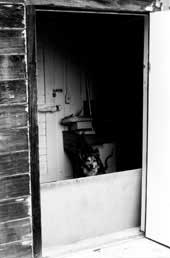 Wilson:
Right, who have their own belief system. And really, to our minds
this people are doing work very similar to the work that the astronomers
were doing in Mount Wilson. The astronomers, it`s what they`re really
doing is tackling the large questions of existence, like "where do
we come from?" "What is the source of existence?" To a certain extent,
I suppose what I should say they are looking for what the purpose
of the astronomer actually is. But the people that wrote the letters
to Mount Wilson had very much the same questions. The astronomers
bring all the resources available to them, to bear on these questions.
These individuals definitely bring all the resources they have available
to bear on often times seemingly backwards questions. So those people
are very inspirational to us. We consider it an enormous opportunity
to be able to show their work, and to act in ways as an amplifier...
to put their words... to help their words reach a larger audience.
Wilson:
Right, who have their own belief system. And really, to our minds
this people are doing work very similar to the work that the astronomers
were doing in Mount Wilson. The astronomers, it`s what they`re really
doing is tackling the large questions of existence, like "where do
we come from?" "What is the source of existence?" To a certain extent,
I suppose what I should say they are looking for what the purpose
of the astronomer actually is. But the people that wrote the letters
to Mount Wilson had very much the same questions. The astronomers
bring all the resources available to them, to bear on these questions.
These individuals definitely bring all the resources they have available
to bear on often times seemingly backwards questions. So those people
are very inspirational to us. We consider it an enormous opportunity
to be able to show their work, and to act in ways as an amplifier...
to put their words... to help their words reach a larger audience.
And the other exhibition? "The Sonnabend Hall" . There is a combination, more like a family thing.
Wilson: Well, the title of that exhibition is: "The Delany Sonnabend Halls". And it details that work of Madalena Delany... by a collection of art songs, primarily operatic material and Jeffrey Sonnabend who was a neuro-physiologist and memory researcher. It talks about each of their life work, and their lifes. But it also brings to life an almost invisible thread that tied their lives together. Like a spiders web, almost invisible. The thread is that Madalena Delany suffered from a condition, called Korsakoff syndrome, which is a failure of short term memory. In her case, she had no short term memory. Coincidentlaly, the night that Jeffrey Sonnabend heard her sing, he had hit upon the idea for the theory of obliscence. Where his theory of forgetting came from. Now it does seem more than a coincidence, on the very night he heard this woman who had memory difficulties sing, that his idea for the nature of forgetting came to him. That`s why some people have accused us of making a mountain out of a molehill.
If you have some problems with the language, and you (mainly) look at the artefacts, then you think, on the first view, more about curiosity.
Wilson: Right. I am very aware of that. I don`t know for certain, what to do about it, that the museum depends so much on language. Even people whose English is as good as yours I`m sure that they are just things that don`t... But then they probably have a different experience and that`s fine.
And the library here? Is it the library of the museum?
Wilson: This is the library of the museum. It`s called "The Library for the diffusion of useful information and Sarah Simons reading room". It`s just a library, and it`s primarly but not entirely put together by Sarah Simons our librarian. She has donated a great many books. The head of research here is a man called Chambers, he has donated a great many of books as well. And then people just from the public at large donate books quite regularly.
We saw this oven for burning clay. And that you have a copy stand here next to a lot of other tools. Do you try to build up the museum as independent as possible?
Wilson: Well, we would like to be able to do as much in house as possible... a great part of the museum is economics. We`re simply underfunded, even though we have a fiercely loyal membership. We`re supported then a lot by donations, door donations, sales and gift items. Then there is grant applications, still for all that we`re still horribly underfunded. So the more we can do inhouse the easier it is for us to remain here.
How do the volunteers and members of the museum get in touch with it? Are they just friends, and then bring their friends?
Wilson: No. Typically, everybody that is involved at the museum has just been drawn to it. But they`re all just people that came to the museum and wanted to stay out of interest. They are just an amazing and wonderful group of people.
We thought too, that the atmosphere is very much a group atmophere, it`s very collaborative.
Wilson: Yes, it`s very collaborative. We like to have it be very non-hyrarchical. Nobody particularly has titles. There are areas of interest. Like Sarah is very interested in books so she became the librarian, but she does lots of other things too. People naturally gravitate to things they like to do. But not like, there are particular curators, you know. We don`t have curatorial systems and things like that. Anybody can curate, anybody can design, and everybody does.
I don`t know if this is acknowledged from the outside? But in my opinion this is a main difference to other museum systems.
Wilson: Yes, they`re more traditional. I am sure there are museums like ours, that have a kind of non-hierarchical (viewpoint). But I think you're right. I think in general museums tend to be much more hierarchical.
And how does the developing of an exhibition work? People have an idea, and all of you discuss the idea?
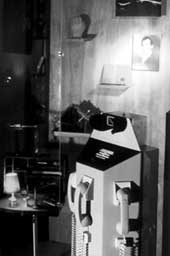 Wilson:
Yes. It`s not formal. It`s defintely not formal. There are often usually
a number of ideas out there for possible exhibits. Often the best
thing is, when you kind of forget whose idea it was. You know, when
it`s so amorphous that it`s not quite clear whose idea it was, you
know everybody just knows that the idea is out there and we`re all
kind of thinking about it. It`s a very organic process. It`s very
hard to define how the ideas actually work their way through becoming
an exhibition. Well, a bit part of it is, the ones that get funded.Because
we very often take these ideas and write them as grant proposals,
and clearly the ones that get funded are much more likely to be made
than the ones that don`t get funded. But that`s not the only criteria.
A lot of the time we`ll do smaller exhibits without specific grant
funding. And I think that the ideas kind of evolve on their own. It
often times will take years and years and years for an idea to like
finally make it`s way through and then all of a sudden it will gain
a lot of momentum and become a show. "Tell the Bees" was like that.
We`d been talking about that,... It began with an encyclopedia that..
it`s called the "Encyclopedia of Vulgar Beliefs", that came from,
like the last part of last century, that Sarah found in a used book
store. We all just started looking at it, talking about it and thinking
about it. It stayed in that state about two years, and all of a sudden
just caught fire and it was still another year, or a year and a half,
before it actually was done. So there is a lot of ideas like that
floating around.
Wilson:
Yes. It`s not formal. It`s defintely not formal. There are often usually
a number of ideas out there for possible exhibits. Often the best
thing is, when you kind of forget whose idea it was. You know, when
it`s so amorphous that it`s not quite clear whose idea it was, you
know everybody just knows that the idea is out there and we`re all
kind of thinking about it. It`s a very organic process. It`s very
hard to define how the ideas actually work their way through becoming
an exhibition. Well, a bit part of it is, the ones that get funded.Because
we very often take these ideas and write them as grant proposals,
and clearly the ones that get funded are much more likely to be made
than the ones that don`t get funded. But that`s not the only criteria.
A lot of the time we`ll do smaller exhibits without specific grant
funding. And I think that the ideas kind of evolve on their own. It
often times will take years and years and years for an idea to like
finally make it`s way through and then all of a sudden it will gain
a lot of momentum and become a show. "Tell the Bees" was like that.
We`d been talking about that,... It began with an encyclopedia that..
it`s called the "Encyclopedia of Vulgar Beliefs", that came from,
like the last part of last century, that Sarah found in a used book
store. We all just started looking at it, talking about it and thinking
about it. It stayed in that state about two years, and all of a sudden
just caught fire and it was still another year, or a year and a half,
before it actually was done. So there is a lot of ideas like that
floating around.
So, there are mainly two different kinds of exhibitions? The ones where you get a kind of collection, and curate it, and the other ones are developed by own ideas?
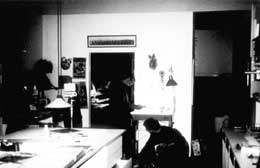 Wilson:
Homespun. Right, yes, exactly. There are two kinds. In our mission
statement we actually state that. We`re interested in first presenting
the work of this group of people. The exhibitions, that have been
conceived of, and executed by this group of people. But in addition
we are interested in bringing in and displaying the work of people
that practice unusual and often times idiosyncratic forms of enterprise.
Like Hagop Sandaldjian`s microminiatures are very typical of that.
We had other people, other kinds of similar things, where they`re
just curious endeavors and usually unrecognized, or underrecognized.
Things that aren`t getting seen at other kinds of cultural institutions.
We`re mostly interested, even in the exhibits more in the permanent
collection and the work like "Sonnabend." We like to often times put
work into the world that we think is of value, but has not become
mainstream.
Wilson:
Homespun. Right, yes, exactly. There are two kinds. In our mission
statement we actually state that. We`re interested in first presenting
the work of this group of people. The exhibitions, that have been
conceived of, and executed by this group of people. But in addition
we are interested in bringing in and displaying the work of people
that practice unusual and often times idiosyncratic forms of enterprise.
Like Hagop Sandaldjian`s microminiatures are very typical of that.
We had other people, other kinds of similar things, where they`re
just curious endeavors and usually unrecognized, or underrecognized.
Things that aren`t getting seen at other kinds of cultural institutions.
We`re mostly interested, even in the exhibits more in the permanent
collection and the work like "Sonnabend." We like to often times put
work into the world that we think is of value, but has not become
mainstream.
How do you want to go on in the future? Do you want to expand?
Wilson: Well, we in our own limited way we`ve physically expanded a lot over the last three years. We expanded twice, and each time we do that it`s quite demanding. And now, I think, that we need a period of time of restabilizing. But we don`t imagine any physical expansion in the near future with the possible exception of putting a botanical garden in the back, where that parking lot now is. We want to build a botanical garden back there, where people can go.
And expanding? Could it also mean, that you give more exhibitions to other institutions like you gave them to Hagen, to the Karl Ernst Osthaus Museum, and to other places before?
Wilson: But even those will draw an enormous amount from our resources as well. We would like to be able to continue to provide new exhibitions to Hagen.
Can you explain what happens in Hagen? We heard, that it is a kind of inlay in a museum?
Wilson: There is a museum called Karl Ernst Osthaus Museum and they have built a new museum, and then kind of left their older building. That was built in the early years of this century. It was designed by a man named Van de Velde, a wonderful architect. And that space kind of became unfocussed for them. They just had uninteresting things in this older space. When the director of that museum came here, he liked our museum, and he liked to offer us this space to do a branch of our museum there. It`s wonderful... they manage it... it's wonderful to do it there...
Is there a German staff working for your museum over there, or is it all about bringing it from California to them?
Wilson: It`s currently more... we have been bringing things from our museum to their museum. But we would like to, like work out a kind of relationship with them as well. We are talking about that. Definitely, we're talking about joint exhibitions and things that are co-curated.
But in a way it may be difficult too. Because Hagen, I suppose, is a conventional organised museum, and it`s difficult to transform the way the "Museum of Jurassic Technology" works?
Wilson: What you are saying is completely true and we are very aware of that. And Michael Fehr the director of that larger museum is very aware of that. But he likes the model of our museum, and likes to make his museum function more like ours does in the culture. He is very conscious of that issue, but it`s more difficult for him. Because he is running a larger, a much larger state funded museum. He is quite an amazing person.
If I say that it`s a romantic work (The MoJT), would you agree with that?
Wilson: I think, I can understand why you say that. It would never have occured to us to use that word.
I mean it in a positive way, not in this "kitsch romantic"way.
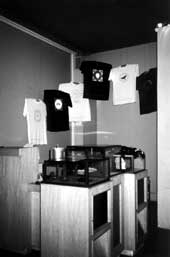 Wilson:
We definitly don't think of ourselves in any way as kitsch. Kitsch
to me usually implies an insincerity or looking at stylistic details
in an insincere way. We`re very serious about what we are doing here,
we believe very seriously in what we are doing here. We consider it
a real mission to do this work. Someone from Italy has asked if the
museum is nostalgic. Which kind of connects to that. I absolutely
disagreed with him, until I understood more the roots of the word
nostalgic as "longing for a home", which is what the derivation of
the word really means. And from that point of view I can understand
it, but in more of a logical sense. I mean that the museum is looking
for, in very much of the larger sense, is looking for a home.
Wilson:
We definitly don't think of ourselves in any way as kitsch. Kitsch
to me usually implies an insincerity or looking at stylistic details
in an insincere way. We`re very serious about what we are doing here,
we believe very seriously in what we are doing here. We consider it
a real mission to do this work. Someone from Italy has asked if the
museum is nostalgic. Which kind of connects to that. I absolutely
disagreed with him, until I understood more the roots of the word
nostalgic as "longing for a home", which is what the derivation of
the word really means. And from that point of view I can understand
it, but in more of a logical sense. I mean that the museum is looking
for, in very much of the larger sense, is looking for a home.